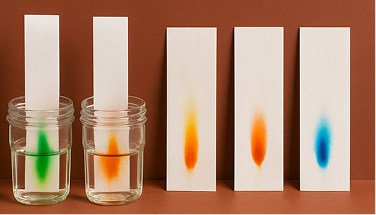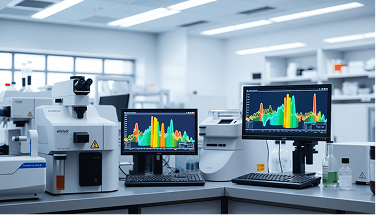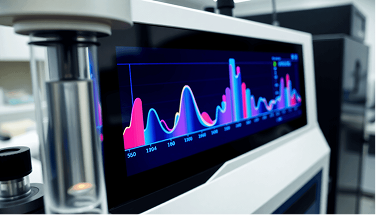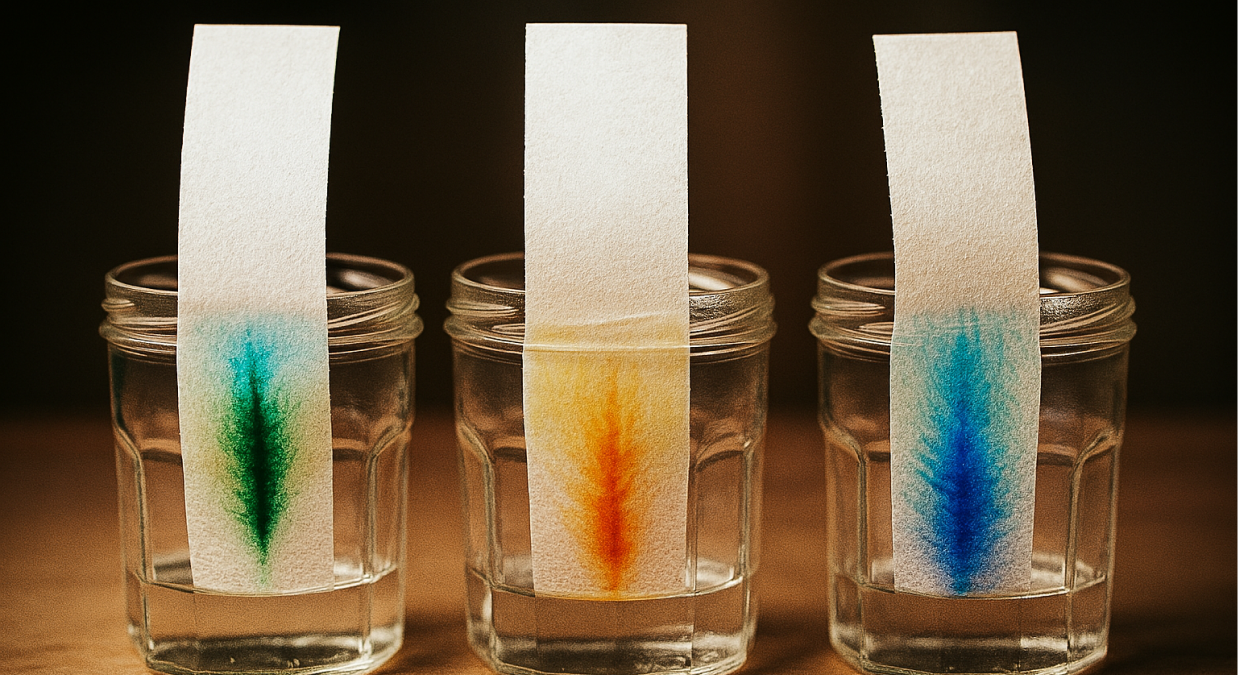Key Takeaways
- Chromatography is essential in pharma for analyzing drug purity, stability, and contaminants.
- The chromatography market is projected to reach USD 13.8 billion by 2030.
- Techniques like HPLC, GC, TLC, and SEC are widely applied in pharma quality control and R&D.
- Selection of stationary/mobile phases critically influences separation quality.
- Mass spectrometry and UV-Vis detectors are central in identifying trace compounds.
- Supercritical CO₂ and solvent recycling contribute to green chromatography.
- FDA/ICH guidelines mandate validated chromatographic methods in pharma QC.
- Real-world applications from Pfizer, Roche, and forensic labs highlight chromatography's impact.
Abstract
Chromatography plays a central role in pharmaceutical R&D, clinical diagnostics, and manufacturing.
This guide presents its historical evolution, principles, major techniques, and instrumentation. It offers a deep dive into how chromatography ensures drug safety, identifies complex biomolecules, and enables precision in biopharmaceutical workflows.
From TLC to high-end LC-MS/MS systems, the field has grown to meet the needs of complex pharmaceutical analyses.
We also explore sustainability practices and case studies where chromatography reshaped industries—from detecting designer steroids to uncovering toxic food adulterants.
I. Introduction
Chromatography, derived from the Greek for "color writing," is a separation technique now central to analytical chemistry. According to IUPAC, it's a physical method where components distribute between a stationary and a mobile phase moving in a defined direction.
It starts in silence—the lab, the instruments, the analyst peering at a flat baseline on the screen. Then, a subtle peak appears, growing and shifting, telling a story invisible to the naked eye. To an outsider, it's just a curve. But to a pharmaceutical scientist, it's everything.
This is the quiet power of chromatography. What began over a century ago as a technique to separate colored pigments in plants has evolved into the heartbeat of analytical labs across the globe. Today, it guides critical decisions—detecting impurities in life-saving drugs, confirming the structure of complex proteins, or uncovering counterfeit medicines in vulnerable markets.
Behind every successful drug submission, every product release, and every safe dose sits a chromatogram—precise, intentional, and deeply trusted. Chromatography doesn't just separate molecules; it builds confidence in what science claims and patients depend on.
II. Historical Evolution of Chromatography
The roots of chromatography date back to the early 1900s when Russian botanist Mikhail Tsvet separated plant pigments using a calcium carbonate column. The word "chromatography" originated from his observation of colorful pigment bands.
Initially, Tsvet's work didn't gain recognition in Western scientific communities. But his principles laid the groundwork for what would become a revolution in separation science decades later.

By the 1940s, British chemists Archer Martin and Richard Synge advanced partition chromatography, enabling the separation of amino acids using immiscible solvents. Their innovation earned them the Nobel Prize in Chemistry in 1952.
Martin and Synge's work catalyzed the development of planar techniques like paper chromatography and thin-layer chromatography (TLC). These methods democratized separation science and allowed researchers to perform rapid qualitative tests with minimal equipment.
In the 1950s, Martin and Anthony James introduced gas chromatography (GC), enabling separation of volatile compounds at unprecedented resolution. GC became a staple in environmental analysis, petrochemicals, and later, pharmaceutical solvent screening.
By the 1970s, the introduction of High-Performance Liquid Chromatography (HPLC) changed analytical workflows. With high pressure, small-particle columns, and robust detectors, HPLC enabled separation of non-volatile compounds with speed and accuracy.
The 1980s–2000s saw the expansion of specialty techniques such as Ion Exchange Chromatography (IEC), Size-Exclusion Chromatography (SEC), and Affinity Chromatography. These techniques were crucial in protein purification, gene therapy, and vaccine research.
In the 2010s, Ultra-High-Performance Liquid Chromatography (UHPLC) became the gold standard for high-resolution separations. Its ability to operate at higher pressures and smaller particle sizes improved peak resolution and reduced run times.
More recently, Liquid Chromatography coupled with Mass Spectrometry (LC–MS) and tandem MS (LC–MS/MS) have enabled biomarker discovery, impurity profiling, and pharmacokinetics.
These integrations allow for both quantification and structural identification.
Chromatography has evolved from a visual pigment test to an indispensable pillar of pharmaceutical science. Modern methods are faster, more sensitive, and more integrated than ever before.

What is Chromatography? A Beginner's Guide with Examples
Read moreIII. Fundamental Principles of Chromatography
Chromatography separates the components of a mixture based on how differently they partition between two phases: one stationary and one mobile.
The sample is carried by the mobile phase through the stationary phase.
As the sample mixture moves, different compounds interact with the stationary phase to varying degrees. Those with a stronger affinity to the stationary phase move slower, while others elute faster.
This differential interaction causes separation over time, allowing individual analytes to emerge as distinct peaks or bands. Each substance has a characteristic retention time—how long it takes to pass through the column or plate.
These retention times form the basis of qualitative identification. Quantitative analysis is achieved by measuring the peak area in a chromatogram.
The mechanism of separation can involve one or more of the following forces:
Depending on the method, the stationary phase may be a solid (e.g., silica), a liquid immobilized on a solid (e.g., paper or coated gel), or a functionalized resin.
The mobile phase may be a gas, liquid, or supercritical fluid.
For instance, in Gas Chromatography, the mobile phase is typically an inert gas like helium.
In Liquid Chromatography, the mobile phase is often a mix of aqueous buffers and organic solvents.
The performance of a chromatographic system is evaluated using several key metrics:
- Retention Time (tR)
- Retention Factor (k')
- Selectivity (α)
- Resolution (Rs)
- Number of Theoretical Plates (N)
Higher theoretical plate numbers indicate greater column efficiency. Resolution defines how well two peaks are separated, with Rs > 1.5 considered baseline resolution.
Gradient elution (increasing strength of mobile phase over time) is used when analytes have a broad range of polarities. Isocratic elution (constant mobile phase composition) is ideal for simple mixtures.
Temperature, flow rate, column dimensions, and mobile phase composition all impact separation quality. These factors must be optimized for robust, reproducible results.
Chromatography Concepts and Definitions
IV. Major Types of Chromatography
Chromatography is a family of related separation techniques. Each method uses a different stationary/mobile phase combination or separation principle. Broadly, chromatography methods fall into two categories: planar (e.g., paper, TLC) and column-based (e.g., HPLC, GC, SEC). They can also be categorized by mobile phase state—gas, liquid, or supercritical fluid.
Let's now explore each type in detail, with pharmaceutical applications in mind.
Paper Chromatography
This is one of the earliest chromatography forms. It uses filter paper as the stationary phase and a liquid solvent as the mobile phase. The mobile phase moves through the paper via capillary action, separating analytes based on polarity.
Commonly used for separating amino acids, dyes, and pigments in academic and forensic labs.
Though rarely used in pharmaceutical manufacturing today, it's still a popular educational tool.
It's simple, low-cost, and requires no instrumentation.
Thin-Layer Chromatography (TLC)
TLC employs a solid adsorbent (usually silica gel) coated on glass, metal, or plastic plates. Samples are spotted at the bottom, and solvent moves up by capillary action.
TLC is widely used in pharma for:
- Checking raw material purity
- Monitoring synthesis reactions
- Spotting degradation products
Visualized under UV light or with chemical stains, TLC offers fast, inexpensive screening. High-Performance TLC (HPTLC) improves resolution with finer particle size and automated analysis.
Gas Chromatography (GC)
GC uses an inert carrier gas (e.g., helium or nitrogen) as the mobile phase.
The stationary phase is a liquid film coated inside a capillary column.
Samples are vaporized in the injector and separated based on volatility and polarity. GC is highly effective for analyzing:
- Residual solvents in APIs
- Volatile organic impurities
- Essential oils and fragrances
Common detectors include:
- Flame Ionization Detector (FID)
- Electron Capture Detector (ECD)
- Mass Spectrometry (GC-MS)
GC offers excellent resolution and sensitivity, but is limited to thermally stable, volatile compounds.
High-Performance Liquid Chromatography (HPLC)
HPLC is the most widely used technique in the pharma industry. It separates analytes in a pressurized liquid stream through a packed column.
The stationary phase is typically silica-based, modified with chemical groups (e.g., C18 for reversed-phase). The mobile phase is a mix of aqueous buffer and organic solvent.
HPLC is used for:
- API assay and content uniformity
- Impurity profiling
- Drug stability studies
- Pharmacokinetics and bioequivalence
Various detectors are used:
- UV-Vis absorbance
- Fluorescence
- Refractive Index (RI)
- Mass Spectrometry (LC-MS)
Ultra-High-Performance Liquid Chromatography (UHPLC)
UHPLC is an advanced form of HPLC using sub-2 μm particles and higher pressures (up to 15,000 psi). It offers faster separations, higher resolution, and better reproducibility.
Ideal for high-throughput environments, such as:
- Clinical labs
- Pharmacokinetic studies
- Metabolite profiling
Most pharma companies are switching from HPLC to UHPLC for time efficiency and performance.
Ion Exchange Chromatography (IEC)
IEC separates molecules based on charge interactions with the stationary phase. It uses charged resins to bind either cations or anions.
Applications in pharma include:
- Amino acid profiling
- Oligonucleotide purification
- Protein charge variant analysis
IEC is also integral to downstream biopharmaceutical purification. It offers high capacity and is suitable for scale-up.
Size-Exclusion Chromatography (SEC)
SEC, also known as Gel Filtration Chromatography, separates analytes based on molecular size. Larger molecules elute first as they bypass the porous matrix; smaller ones enter the pores and elute later.
It is used extensively for:
- Protein aggregation analysis
- Molecular weight determination of polymers
- Removing small molecule impurities from biologics
SEC is a gentle, non-adsorptive method—making it ideal for fragile biomolecules.
Affinity Chromatography
This highly selective technique relies on specific binding interactions between the analyte and a ligand. For example, a His-tagged protein binds to a nickel-charged column.
Used for purifying:
- Monoclonal antibodies (Protein A columns)
- Enzymes
- Receptor-ligand complexes
Affinity chromatography yields very pure products in fewer steps. It's critical in biologic drug production and quality control.
Supercritical Fluid Chromatography (SFC)
SFC uses supercritical CO₂ as the mobile phase—combining properties of both liquids and gases. It's effective for nonpolar compounds and is considered a green alternative.
SFC applications include:
- Chiral separations
- Natural product purification
- Analytical method development
It consumes less organic solvent, reducing waste and operational costs.
V. Chromatographic Phases, Columns & Solvents
A. Mobile and Stationary Phases
Chromatographic performance largely depends on the careful selection of the mobile and stationary phases. Their interaction with analytes determines retention time, resolution, and overall method success.
In liquid chromatography, the mobile phase is a liquid that flows through the system. It may consist of water, buffers, organic solvents, or combinations of these in gradient or isocratic modes.
The stationary phase is either a solid surface (e.g., silica) or a chemically bonded layer on particles (e.g., C18 alkyl chains). In gas chromatography, the mobile phase is an inert gas, and the stationary phase is a liquid film inside the capillary.
Mobile Phase Types:
- Aqueous (e.g., phosphate buffer, water): For polar compounds
- Organic (e.g., methanol, acetonitrile): For nonpolar or intermediate analytes
- Mixed solvents (e.g., water + ACN): Used in reversed-phase HPLC
- Gases (e.g., helium, nitrogen): For GC
- Supercritical fluids (e.g., CO₂): For SFC applications
Stationary Phase Types:
- Silica: Used in normal-phase and reversed-phase chromatography
- C18/C8: Hydrophobic bonded phases for reversed-phase HPLC
- Diol, cyano: Polar phases used in normal-phase LC
- Ion exchange resins: Charged polymers for IEC
- Gel beads (e.g., dextran, agarose): For SEC
- Affinity ligands: Protein A, nickel NTA for specific interactions

Mobile vs Stationary Phases in Chromatography: A Detailed Comparison
Read moreB. Column Types and Specifications
The chromatographic column is the heart of the separation.
It holds the stationary phase and defines pressure, resolution, and throughput.
In HPLC and UHPLC, columns are stainless steel tubes packed with silica-based particles (1.7–5 µm). Shorter columns (e.g., 50 mm) are used for fast runs; longer ones (e.g., 250 mm) for better resolution. In GC, columns are typically long (15–60 m), thin fused silica capillaries coated with liquid stationary phase. Their inner diameters (ID) range from 0.1 to 0.53 mm.
In SEC, columns are wider (7.5–10 mm ID) and packed with porous beads tailored to molecular size cutoffs. Affinity columns are designed with ligands attached to supports and are often used in cartridge formats.
Column Types by Chromatography Mode:
- Reversed-phase LC: C18, C8, phenyl, cyano columns
- Normal-phase LC: Silica, diol, amino columns
- Ion-exchange LC: Strong/weak anion and cation exchangers
- SEC: Sephadex, Superdex, TSKgel
- Affinity: Protein A/G/L, IMAC (Ni, Co), lectin columns
- GC: DB-5, HP-1, HP-INNOWax, VF-5ms, etc.
C. Solvents Used in Chromatography
Solvents must be pure, volatile (for GC), and compatible with the analyte and detection method. Their polarity, viscosity, and UV cut-off influence separation quality and detector response.
In reversed-phase HPLC, acetonitrile (ACN) and methanol (MeOH) are most common. Water, often buffered with phosphate, citrate, or formate, is also used.
In normal-phase HPLC, hexane, heptane, and ethyl acetate are common nonpolar solvents.
For ion chromatography, aqueous buffers (e.g., sodium bicarbonate, potassium hydroxide) are typical.
For GC, high-purity helium or nitrogen is used as the carrier gas. In SFC, supercritical CO₂ (sometimes with MeOH as co-solvent) is the main component.
VI. Sample Preparation, Detection Methods & Method Validation
A. Sample Preparation Techniques
Sample preparation is the foundation of accurate chromatography.
It improves analyte concentration, removes interferences, and extends column life.
Typical preparation steps include:
- Dilution
- Filtration (e.g., 0.45 μm membrane)
- Centrifugation to remove particulates
- pH adjustment or buffering
- Pre-concentration (e.g., lyophilization or SPE)
Solid-Phase Extraction (SPE) is common in bioanalysis. It concentrates analytes and eliminates proteins or salts before LC–MS or HPLC.
Liquid–Liquid Extraction (LLE) is used for hydrophobic drugs and plasma samples. It separates compounds into immiscible layers based on polarity.
For proteins and mAbs, buffer exchange and filtration are standard. Ultrafiltration, desalting columns, and affinity capture may be used before SEC or ion exchange.
Proper sample prep ensures peak shape, retention time consistency, and instrument protection. Neglecting it can lead to carryover, ghost peaks, and matrix effects.

How Chromatography Works: Principles and Separation Mechanisms
Read moreB. Detection Methods in Chromatography
Detectors translate the presence of analytes into measurable signals. Choice of detector depends on analyte type, matrix, and detection limits required.
Common detectors in HPLC and UHPLC include:
UV-Vis Absorbance:
Measures the absorbance of UV or visible light at specific wavelengths. Useful for compounds with chromophores (e.g., aromatic rings, conjugated systems).
Diode Array Detector (DAD/PDA):
Scans multiple wavelengths simultaneously, producing spectra for peak identification. Useful in method development and impurity profiling.
Fluorescence Detector:
High sensitivity for naturally fluorescent or derivatized compounds. Widely used for vitamins, polycyclic aromatics, and clinical drugs.
Refractive Index Detector (RID):
Universal detector that measures change in refractive index. Used for sugars, lipids, and polymers that lack UV absorbance.
Conductivity Detector:
Mainly used in ion chromatography. Quantifies ionic species in environmental and pharma samples.
Evaporative Light Scattering Detector (ELSD):
Detects non-volatile solutes by measuring light scattering. Applicable to lipids, surfactants, and compounds with poor UV absorbance.
Mass Spectrometry (MS, MS/MS):
Most powerful detector for structural identification and trace quantitation. Combines separation with accurate mass data, especially in LC–MS and GC–MS.
Flame Ionization Detector (FID – GC):
Quantifies organic compounds based on ionization in a flame. Highly sensitive and used for volatile solvents, hydrocarbons.

Chromatography Detectors Explained: UV, RI, MS, and More
Read moreC. Regulatory Method Validation (ICH, FDA)
Validation ensures that a chromatographic method is reliable, reproducible, and compliant.
In pharma, regulatory agencies like the FDA and EMA follow ICH guidelines (Q2(R2)) for validation.
Core validation parameters include:
Specificity:
Ability to measure the analyte without interference from excipients or impurities. Verified through blank, placebo, and spiked samples.
Linearity:
Demonstrates that detector response is directly proportional to analyte concentration. Typically evaluated over 5–7 concentration levels.
Accuracy:
Assesses closeness of measured value to true value. Determined by recovery studies at multiple levels (e.g., 80%, 100%, 120%).
Precision:
Measured as repeatability (intra-day) and intermediate precision (inter-day). Expressed as %RSD of replicate injections.
Limit of Detection (LOD) and Limit of Quantitation (LOQ):
Lowest concentration that can be detected or reliably quantified. Calculated from signal-to-noise ratio or standard deviation methods.
Robustness:
Evaluates sensitivity of results to small changes in method parameters (e.g., pH, temperature, flow). Ensures consistency under varied lab conditions.
System Suitability:
Set of tests performed before analysis to confirm instrument readiness. Includes resolution, tailing factor, theoretical plates, %RSD of peak area.
Stability:
Assesses analyte stability under sample handling and storage conditions. Important in method transfer and bioanalysis.
ICH also emphasizes lifecycle management of analytical procedures. This includes continual method monitoring (Analytical Quality by Design, AQbD) and change control. Compliance with validation protocols ensures the method is fit-for-purpose. It is a legal requirement for all marketed pharmaceutical products.
VII. Green and Sustainable Chromatography
As environmental awareness grows, green analytical chemistry has become a priority. Chromatography labs generate large volumes of hazardous solvents and waste, especially in HPLC.
Solvent disposal is both costly and environmentally burdensome. For example, an average HPLC method may use 0.5–2 L of solvent per day.
Sustainable strategies include:
- Using shorter UHPLC columns (less solvent per run)
- Adopting water-rich mobile phases where possible
- Recycling organic solvents through purification systems
- Switching from ACN to EtOH (more biodegradable)
- Using supercritical CO₂ in SFC for lower environmental impact
SFC is considered a green alternative to normal-phase LC. It reduces waste, lowers solvent usage, and shortens run times significantly. Several companies now offer solvent recovery systems. These help labs reclaim up to 95% of ACN and MeOH used in HPLC workflows.
Agilent and Waters both promote sustainability in their instrumentation. They provide energy-efficient LC modules and offer eco-friendly consumables.
Green chromatography not only reduces costs but also helps pharmaceutical companies meet ESG goals. It is now being recognized by the FDA and EMA as part of lifecycle sustainability assessments.
VIII. Case Studies in Pharma and Industry
Pfizer – Chromatography in COVID-19 Vaccine QC
Pfizer used UHPLC extensively for mRNA vaccine release testing.
Their QC methods included SEC for capsid integrity and HILIC-LC for impurity analysis.
Every lot of vaccine undergoes over 40 analytical tests before batch release.
Chromatography helped ensure product stability, sterility, and dosage accuracy.
Roche – LC–MS in Monoclonal Antibody Characterization
Roche applied LC–MS for charge variant and glycan analysis in mAbs like Avastin and Rituxan.
Reversed-phase HPLC and SEC were used in tandem to monitor aggregation and oxidation.
The company's Genentech division uses online 2D-LC systems to improve throughput.
This reduced analytical timelines from days to hours in biologic characterization.
Thermo Fisher Scientific – Ion Chromatography in API Purity Testing
Thermo's ICS systems were deployed to monitor counterions and residual inorganic species.
In generics production, their IC systems help screen salt forms and water impurities.
They also developed mass detectors compatible with ion chromatography.
This allowed direct mass confirmation in GMP environments.
US Anti-Doping Agency (USADA) – GC–MS for Steroid Detection
GC–MS remains the gold standard for detecting performance-enhancing drugs.
Samples are derivatized and analyzed for steroidal markers like testosterone, trenbolone, and stanozolol.
Chromatographic retention and MS fragmentation patterns confirm violations. USADA's methods meet strict WADA accreditation standards.
WHO – TLC Kits for Counterfeit Drug Detection
The WHO provides portable TLC kits to test antimalarial drugs in low-resource settings.
TLC separates active ingredients and compares retention factors against standards.
Such kits have helped detect falsified artesunate, saving countless lives in Africa and Southeast Asia.
TLC's low cost and simplicity make it ideal for field-based pharma screening.
IX. Emerging Trends and Future Directions
The future of chromatography in pharma is data-rich, automated, and connected.
Hyphenated Techniques
Hyphenated tools like LC–MS/MS, GC–MS, and LC–UV–MS allow deep insight into analyte structure. They reduce false positives and are critical in impurity profiling and bioequivalence studies.
Multi-Attribute Methods (MAM)
Used in biopharma QC, MAM combines LC–MS and peptide mapping to monitor product quality attributes. It replaces multiple single-attribute tests with one comprehensive method.
AI and Automation in Chromatography
Artificial intelligence is being integrated to optimize gradients, identify peaks, and detect anomalies. Systems can now auto-tune injection volume and flow based on sample matrix.
Cloud-connected chromatographs allow real-time monitoring and remote troubleshooting. Vendors like Agilent and Waters have begun rolling out smart systems with machine learning tools.
Digital Twin Technology
In vaccine manufacturing, digital twins simulate the full process, including chromatographic purification. This reduces risk and speeds up tech transfer to new facilities or regions.
Disposable/Prepacked Columns
To support flexible manufacturing, prepacked single-use columns are gaining traction. They reduce cleaning validation time and are ideal for multiproduct facilities.
SFC for Chiral Separations and Natural Products
Supercritical fluid chromatography is being adopted for faster and greener analysis of chiral drugs. It also excels at separating bioactive components in herbal extracts and nutraceuticals.
Regulatory Harmonization of Analytical Methods
Agencies are pushing for globally harmonized methods to reduce duplication. ICH M10 guidance and USP chapters are evolving to incorporate LC–MS and newer platforms.
X. Factors, Instrumentation & Innovations in Chromatography
A. Factors Influencing Chromatographic Separation
Chromatographic resolution and retention are influenced by multiple interrelated factors.
These must be optimized during method development to achieve sharp, reproducible peaks.
Retention Factors
The retention time of analytes is primarily governed by the mobile phase composition, flow rate, column temperature, and nature of the stationary phase.
Higher affinity to the stationary phase generally results in longer retention.
Resolution and Efficiency
Column resolution depends on efficiency, selectivity, and retention differences.
Theoretical plate number (N) reflects column efficiency—higher N values yield narrower peaks.
The Van Deemter equation explains how factors like particle size, flow velocity, and mass transfer resistance impact resolution.
Selectivity
Alterations in mobile or stationary phase polarity can significantly influence analyte separation.
In reversed-phase HPLC, changing the ratio of water to organic solvent adjusts the elution order.
Capacity Factor (k')
A balance between resolution and run time is achieved by tuning the capacity factor.
Too high a k' leads to long runtimes; too low causes poor separation.
B. Chromatographic Instrumentation Overview
Basic Instrument Components
A chromatography system typically includes:
- Pumps: Maintain mobile phase flow (isocratic or gradient)
- Autosampler or injector: Introduces the sample with precision
- Column: Core separation component
- Detector: Converts analyte signal into measurable data
- Data system: Records, processes, and displays chromatograms
Advanced Instrumentation
Modern systems include:
- UHPLC: Uses sub-2 μm particles and high pressures for superior resolution
- Tandem Systems:
- LC–MS: Structural ID and trace quantification
- GC–MS: Volatile compound analysis with fragmentation data
- LC–NMR: Structural elucidation in complex mixtures
Detection Methods
A wide range of detectors support different analytical needs:
- UV–Vis: Most common, for chromophoric compounds
- Fluorescence: High sensitivity for tagged molecules
- RI (Refractive Index): Universal but less sensitive
- Electrochemical: For redox-active compounds (e.g., neurotransmitters)
- Mass Spectrometry (MS): Enables both identification and quantitation
- NMR Detection: Highly detailed, used for structure confirmation
C. Recent Innovations and Trends
Automation
Modern platforms offer automated sample prep, peak detection, and result interpretation. AI-enabled software now suggests optimal gradients and flags anomalies in real time.
Miniaturization
Microfluidic and capillary-scale chromatography reduce solvent usage and support portable devices. These mini systems are suited for point-of-care diagnostics and forensic analysis.
Online Analysis
Process Analytical Technology (PAT) uses online chromatography to monitor real-time batch performance. This reduces production delays and supports continuous manufacturing.
Multidimensional Chromatography (2D-LC, 2D-GC)
These systems combine orthogonal separation modes to resolve highly complex samples. Used in protein characterization, extractables and leachables, and impurity profiling.
Green Chromatography
Environmentally friendly techniques include:
- Supercritical Fluid Chromatography (SFC) using CO₂
- Replacing ACN with ethanol or water-rich solvents
- Shorter columns and reduced flow rates to limit solvent consumption
Emerging Applications
Chromatography is expanding into:
- Biopharmaceuticals: mAb charge variants, host cell protein profiling
- Complex environmental matrices: PFAS, microplastics, pesticide residues
- Cell and gene therapies: Viral vector purity and capsid analysis
XI. Conclusion
Chromatography has evolved from a basic pigment-separation technique into a cornerstone of modern pharmaceutical science. It now underpins every stage of the drug lifecycle—from early-stage research to large-scale manufacturing, regulatory release, and post-market analysis.
Its ability to resolve, detect, and quantify complex molecules makes it indispensable for maintaining quality, safety, and efficacy in pharmaceutical products. With global agencies enforcing stricter quality norms, chromatography's role in method validation and compliance has never been more critical.
Today, high-throughput systems, multidimensional platforms, and green workflows have made chromatographic analysis faster, cleaner, and smarter. Emerging technologies like multi-attribute methods (MAM), digital twins, and disposable columns are redefining how pharma companies approach quality control. Chromatography is no longer just an analytical tool—it's an integral part of the pharmaceutical innovation engine.
Looking ahead, the integration of AI-driven optimization, cloud-based monitoring, and green solvents will further enhance its versatility. Digitalization will improve predictive modeling and troubleshooting, while automation will streamline large-scale manufacturing analytics. Sustainability will also remain a key driver, as companies move toward environmentally conscious separation technologies. In every aspect—speed, precision, sensitivity, and compliance—chromatography continues to push boundaries and set industry benchmarks.
XII. References
- IUPAC Gold Book – Chromatography definition
- Grand View Research – Chromatography Market Report (2024–2032)
- Pfizer – Science Behind the COVID-19 Vaccine
- WHO – Counterfeit Medicines Factsheet
- ICH Guidelines (Q2(R2) – Analytical Validation)
- Agilent Technologies – Sustainability in LC
- Waters Corporation – Green Chemistry Resources
- Thermo Fisher Scientific – Chromatography Instruments
- US Anti-Doping Agency – Analytical Testing Overview
- European Medicines Agency – Guidelines on Bioanalytical Method Validation
- Analytical Quality by Design (AQbD) – FDA Perspectives
- Journal of Chromatography A (Elsevier) – LC–MS Applications
- USP General Chapters on Chromatography
